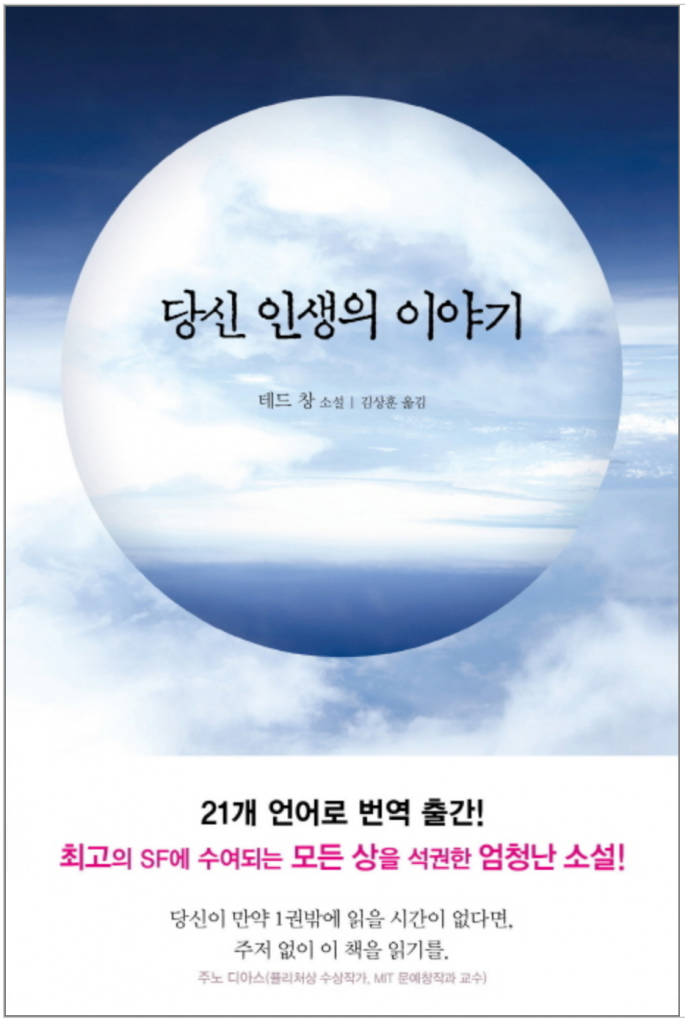
Movie buffs might recognize this work as the inspiration for Denis Villeneuve’s ‘Arrival’. But, this piece is a legendary short story in the world of science fiction, earning Ted Chiang prestigious awards like the Nebula and Sturgeon Awards. 🌟
If you love sci-fi, Ted Chiang is a name you surely know. Personally, I’m a fan too. One reason I admire his work is his precise scientific grounding. Unlike authors who rely solely on imagination, Chiang’s stories are rooted in real science. This makes his work a bit challenging, but for readers interested in scientific theories, it’s a delightful experience! 🧠📚
Another reason is the deeper message he conveys. He focuses on philosophical themes rather than just futuristic sci-fi elements. Some might even question if his stories are truly sci-fi. Yet, unlike some niche writers, Chiang’s tales are rich in literary expression and profound thought. Truly a treat to read! ✍️✨
‘Story of Your Life’ first appeared in 1998 and was later included in the 2002 collection ‘Stories of Your Life and Others’. 📖
While this story was adapted into a film, Villeneuve’s ‘Arrival’ emphasizes the sci-fi elements, focusing on aliens and communication. To visualize it for a wider audience, this approach was likely necessary. The novel also dedicates much space to the linguistic and scientific theories and trials involved in communicating with aliens. Most reviews highlight the linguistic angle or the sci-fi aspects based on Fermat’s principle. However, I see the aliens and communication as logical tools to express the story’s theme. 🤔
If I were to write the book’s blurb, it might go something like this:
One day, aliens suddenly appear on Earth, confronting humans. To decode their intentions, communication is crucial! Linguist Louise and physicist Gary step in…
Sounds very sci-fi, right? But I probably wouldn’t include the deeper messages in the blurb, since that might not attract hardcore sci-fi fans. 🚀
This tale is about Louise, a linguist who, by understanding the alien language, gains the ability to see the future, including the life of her future daughter. The story weaves the process of communicating with aliens with the life of Louise’s daughter. 👶🔮
Louise learns to see the future through the alien language, a future she can’t change with free will. Ted Chiang brilliantly uses Fermat’s principle to logically prove this in the story. (I’ll hope to explain Fermat’s principle in another post!) 📜✨
The story is narrated from a point where the aliens have left Earth, and it’s been two years since Louise married physicist Gary. They watch a dinner show, and under the moonlight, they decide to have a child. But Louise already knows her child will be a daughter, she’ll part ways with Gary, and her daughter will die at 25. So, even as they decide to have a child, she knows everything about her daughter’s life. 🌙❤️
Louise calmly narrates her unborn daughter’s life, knowing the unhappy fate awaiting her. Even though destiny is against her, she knows she will have the child. Despite the tragic end, every experience will give life its meaning. 🌼
Ted Chiang uses the futuristic setting of alien encounters to tell a story about ‘fate beyond human control’. The acceptance of human limits and the inevitability mimics Eastern philosophical approaches like fate or reincarnation. Yet, Louise’s acceptance of her fate without despair mirrors Heidegger’s fundamental ontology, suggesting that future death is a tool to reflect on one’s life. Humans are beings thrown into existence without choice but are constantly projecting themselves. This mirrors Louise’s acceptance of fate. ✨🌌
Isn’t it refreshing to see philosophical ideas proven within a sci-fi setting using physics theories? This is what sets Ted Chiang apart, even with fewer than 20 works over 30 years. 🌟
The weather’s great, so if you haven’t read it yet, why not give it a try today? It’s short, perfect for a quick read! 📚☀️
Leave a Reply